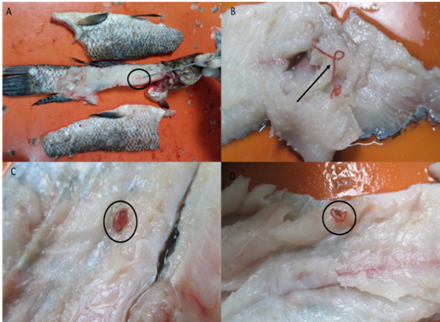Parasitic metazoans in Hoplias malabaricus (Bloch, 1794) "fasaco" collected at the Belén market, Iquitos-Peru
DOI:
https://doi.org/10.51252/raa.v3i2.531Keywords:
parasites, metazoan, pentastomid, prevalence, zoonosesAbstract
The work was carried out by direct observation, search and identification of the endoparasitic fauna of Hoplias malabaricus both in internal organs and in the musculature of 50 specimens. The analysis of the fish was carried out at the Parasitology and Aquaculture Health Laboratory of the Peruvian Amazon Research Institute (IIAP). Seven nematodes (Eustrongylides sp, Procamallanus sp, Contracaecum sp, Spiroxys sp, Pseudoproleptus sp, Terranova sp, Heliconema sp); one trematode (Ithioclinostomun sp) and one pentastomid (Sebekia sp) were identified. Of the parasites mentioned, zoonotic parasites (Eustrongylides sp., Contracaecum sp., Terranova sp., Ithioclinostomun sp. and Sebekia sp.) that could be transmitted and cause harm to humans (zoonosis) were identified. Likewise, the calculation of the parasitic indexes was carried out to take into account the degree of parasitic infection that these fish possess, having genera Eustrongylides sp. and Heliconema sp. as dominant in these indexes with a prevalence of 26% and 18%; intensity of 28 and 78 individuals, mean intensity of 2.15 and 8.67, and mean abundance of 0.56 and 1.56 respectively. It is concluded that the fauna of endoparasites found in Hoplias malabaricus "Fasaco" analyzed in the present study is represented by nematodes, trematodes and pentastomids; finding among these groups zoonotic species.
Downloads
References
Belei, F., Ferreira, S. R., Perin, L. M., Braga, F. R., Sampaio, W. M. S., Araújo, J. V. de, Dergam, J. A., & Takemoto, R. M. (2013). First report of austrodiplostomum compactum and ithyoclinostomum dimorphum in trahira (hoplias malabaricus) from the middle course of the Rio Doce, Minas Gerais, Brazil. Arquivos Do Instituto Biológico, 80(2), 249–252. https://doi.org/10.1590/s1808-16572013000200017
Benigno, R. N. M., Clemente, S. C. de S., Matos, E. R., Pinto, R. M., Gomes, D. C., & Knoff, M. (2012). Nematodes in Hoplerytrinus unitaeniatus, Hoplias malabaricus and Pygocentrus nattereri (pisces characiformes) in Marajó Island, Brazil. Revista Brasileira de Parasitologia Veterinária, 21(2), 165–170. https://doi.org/10.1590/S1984-29612012000200018
Brusa, R. G., Chemes, S. B., & Rossi, L. M. (2020). Helmintofauna de hoplias malabaricus en humedales de la planicie de inundación del río paraná medio, Argentina. Neotropical Helminthology, 13(2). https://doi.org/10.24039/rnh2019132640
Chero, J., Sáez, G., Iannacone, J., & Aquino, W. (2021). Aspectos ecológicos de los helmintos parásitos de lorna sciaena deliciosa (tschudi, 1846) (perciformes: sciaenidae) adquiridos del terminal pesquero de ventanilla, callao, Perú. Neotropical Helminthology, 8(1). https://doi.org/10.24039/rnh201481899
Ferre, I. (2016). Anisakiosis y Gnathostoma pero no en tilapia - Anisakiosis y otras zoonosis parasitarias transmitidas por consumo de pescado. Revista AquaTIC, 14. http://www.revistaaquatic.com/ojs/index.php/aquatic/article/view/134/123
Flores Cabezas, I. C. (2018). Estudio de parasitosis gastrointestinal en dos especies de aves acuáticas y peces como indicadores de salud ecológica de la laguna de Yahuarcocha [Universidad Central del Ecuador]. http://www.dspace.uce.edu.ec/handle/25000/15556
García Dávila, C., Sánchez Riveiro, H., Flores Silva, M. A., Mejía de Loayza, E., Angulo Chávez, C., Castro Ruiz, D., Estivals, G., García Vásquez, A., Nolorbe Payahua, C., Vargas Dávila, G., Núñez, J., Mariac, C., Duponchelle, F., & Renno, J.-F. (2009). Peces de consumo de la Amazonía peruana [Instituto de Investigaciones de la Amazonía Peruana]. https://hdl.handle.net/20.500.12921/368
Luque, J. L. (2020). Parasitos: ¿Componentes ocultos de la Biodiversidad? The Biologist, 6(1). https://revistas.unfv.edu.pe/rtb/article/view/519
Milena Monroy, T. (2019). Identificación de endoparásitos en peces Hoplias malabaricus “fasaco” y Hoplerythrinus unitaeniatus “shuyo” (Erythrinidae) de importancia socioeconómica procedentes de Yurimaguas, Loreto, Perú [Universidad Ricardo Palma]. https://hdl.handle.net/20.500.14138/2022
Moravec, F. (1998). Nematodes of freshwater fishes of the Neotropical Region (1st ed.).
Rodrigues, L. C., Santos, A. C. G., Ferreira, E. M., Teófilo, T. S., Pereira, D. M., & Costa, F. N. (2017). Aspectos parasitológicos da traíra (Hoplias malabaricus ) proveniente da cidade de São Bento, MA. Arquivo Brasileiro de Medicina Veterinária e Zootecnia, 69(1), 264–268. https://doi.org/10.1590/1678-4162-8798
Sanmartin, M. L. (1994). Nematodos parásitos en peces de las costas gallegas (1st ed.). Ediciones Díaz de Santos.
Selis Pinchi, L. E. (2022). Endoparásitos con potencial zoonótico en cinco especies de peces de consumo comercializados en el puerto “Don José” - Iquitos [Universidad Nacional de la Amazonía Peruana]. https://hdl.handle.net/20.500.12737/8227
Valero, A., V., D., & Adroher, F. (2004). Anisákidos parásitos de peces comerciales del Mediterráneo andaluz. BioAndalucía, 1(1), 10–11. https://www.academia.edu/26409521/Anisákidos_parásitos_de_peces_comerciales_del_Mediterráneo_andaluz

Published
How to Cite
Issue
Section
License
Copyright (c) 2023 Cristhofer Cachique-Paredes, Manuel Enrique Navas-Vásquez, Carlos Alfredo Tuesta-Rojas, Germán Augusto Murrieta-Morey

This work is licensed under a Creative Commons Attribution 4.0 International License.
The authors retain their rights:
a. The authors retain their trademark and patent rights, as well as any process or procedure described in the article.
b. The authors retain the right to share, copy, distribute, execute and publicly communicate the article published in the Revista Agrotecnológica Amazónica (RAA) (for example, place it in an institutional repository or publish it in a book), with an acknowledgment of its initial publication in the RAA.
c. Authors retain the right to make a subsequent publication of their work, to use the article or any part of it (for example: a compilation of their works, notes for conferences, thesis, or for a book), provided that they indicate the source of publication (authors of the work, journal, volume, number and date).





